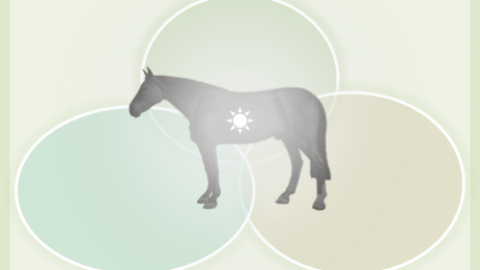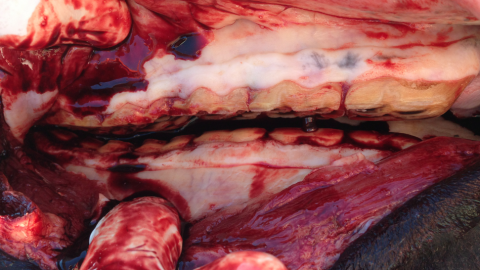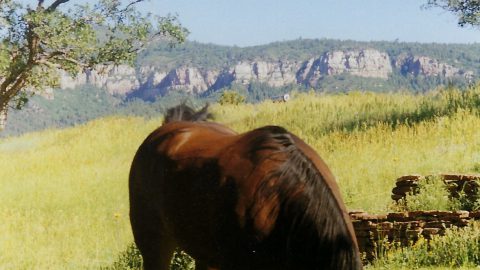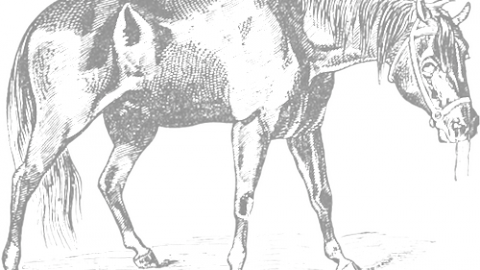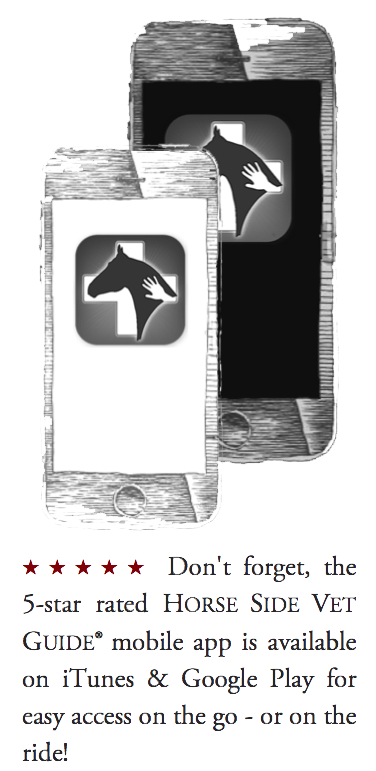Equine Colic (Abdominal Pain): Part I
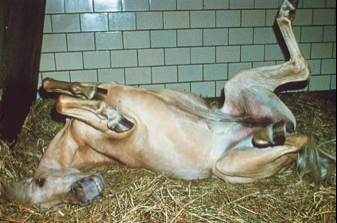
Horse in Abdominal Pain – Rolling
It always surprises me when an experienced horse person asks me how I treat “colic.” That question is akin to asking a physician how they treat a “limp.” Equine colic is simply abdominal pain. Signs of equine colic are what we see – a horse’s behavior when it is experiencing abdominal pain. Like a limp, colic can be caused by any of a large number of conditions (diagnoses). The key question we (vets and horse owners) must always ask is: What is the condition (diagnosis) that is causing the colic? The answer provides the information needed to determine how it should be treated.
The term “colic” tends to cause confusion and panic among horse owners. There are many misconceptions and oversimplified statements about colic in horses. Examples that I hear frequently:
-
Horses colic when the barometric pressure drops.
-
If you keep a horse from rolling, he can’t twist his intestine.
-
Putting a colicy horse in a trailer and driving around will “fix” him.
-
If a colicy horse passes manure, they are getting better.
Too often, I see the results of this flawed logic, which leads to delayed treatment and sometimes death.
THE EQUINE GASTROINTESTINAL TRACT
 Since intestinal problems are so common in horses, it’s important for every horse person to know something about colic, and the basics of equine intestinal health.
Since intestinal problems are so common in horses, it’s important for every horse person to know something about colic, and the basics of equine intestinal health.
The equine gastrointestinal tract is unique in is its ability to utilize cellulose and other structural carbohydrates (the fibrous part of grass that is poorly digestible). The process of breaking down this carbohydrate into useable nutrition is called fermentation, which requires a specialized and complicated intestinal tract. Fermentation produces large quantities of gas and requires a complex ecology of microbes. This sophisticated system has worked well for wild horses for millions of years, but does not function as well for our stabled horses that are sedentary and fed 2 meals per day.
A TRIP DOWN THE EQUINE GASTROINTESTINAL TRACT
From the mouth, feed travels through the esophagus to a small, 3-5 gallon stomach, and then moves into a narrow, slick and slithering, 70-foot long hose – the small intestine. From here, the partially digested feed moves into a 3-foot long, sock-shaped, 5 – 7 gallon cecum. The cecum mixes and ferments feed, absorbs water, and empties into a truck tire sized (tractor tire sized in some horses), double horseshoe shaped large colon with a narrow, hairpin turn. The large colon is the “fermentation vat” where roughage is broken down into nutrients and absorbed. After leaving the large colon, manure moves into the 10-foot long small colon, where fecal balls are formed. The manure finally exits at the rectum and anus.
SIGNS OF COLIC
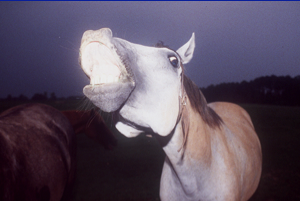
- Lip Curling in Horse Experiencing Abdominal Pain
Horses are very sensitive to abdominal pain and demonstrate it differently than other animals. Signs of abdominal pain in horses range from mild to severe and include: lack of appetite, lethargy, seeming “not quite right”, lip curling, teeth grinding, looking at the side, stretching, pawing, kicking at the belly, lying down, rolling, and many others.
CONDITIONS CAUSING COLIC – CCC’S
Colic signs may result from disturbances that occur anywhere along the gastrointestinal tract, or even from problems with other abdominal organs like the kidney or liver. Intestinal pain can even be confused with pain coming from other areas of the body (examples include muscular pain and chest pain).
Examples of conditions causing colic – lets call them CCC’s for short – can be broken down by the intestinal region that is being affected. For example, the stomach can develop ulcers or an impaction of feed material. The small intestine can be affected by something simple like spasm, or something serious like a twist. The large colon may be affected by simple gas, blocked by a stone or strangled by a twist. Any of these regions can be affected by inflammatory disorders or bacterial infections. These are just a few of many examples of problems causing colic. As a horse owner watching a horse showing signs of colic, you truly have no idea of the condition that is causing it.
What exactly causes pain in horses experiencing colic? Pain arises from a CCC through at least one of the following ways:
-
Tension on attachments of the intestine to the body wall (mesentery).
-
Over-filling (distension) or muscular spasm of part of the intestine. Example: gas accumulation, spasmodic colic.
-
Irritation to the inner surface of intestine. Example: gastric ulcers, blister beetle toxicity.
-
Loss of blood supply to a segment of intestine. Examples include large colon volvulus and thromboembolic colic.



